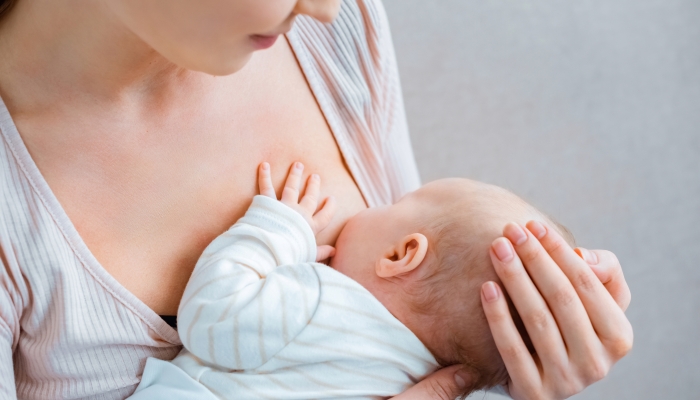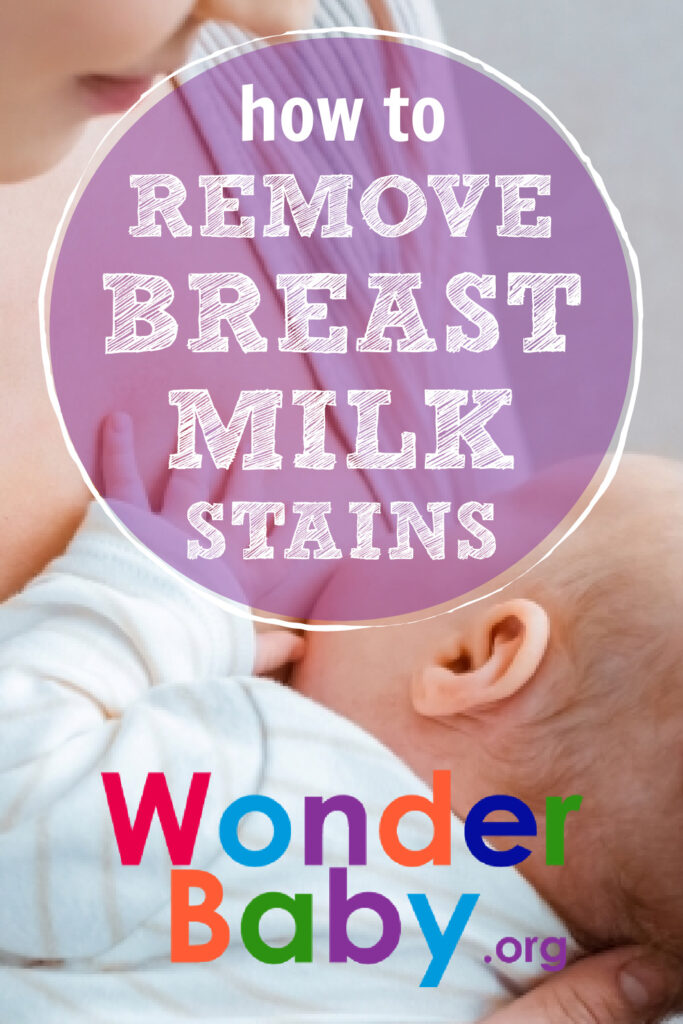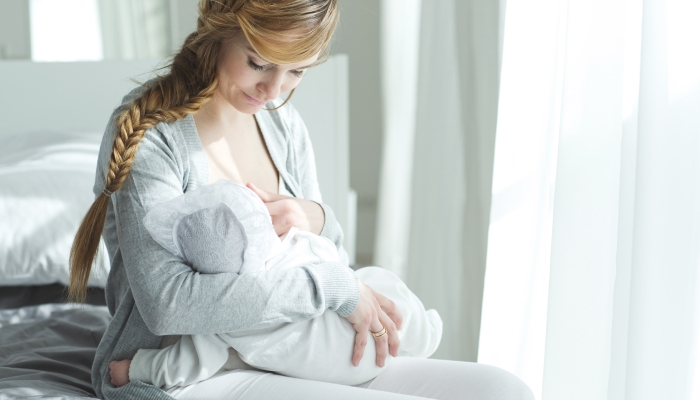Does Breast Milk Stain? Yes! But Here’s How to Remove It

- Breast milk and baby formula can stain clothing just like any other animal-based product because they contain protein and fat.
- You can remove breast milk stains in a variety of ways, but using cool water, soaking your clothes, and applying stain removers and detergents with enzymes are key.
- If possible, it’s best to use gentle cleaning products on your baby’s clothes to help protect their delicate skin.
Breastfeeding is a natural process, but it can be full of challenges for many new parents. There is so much for you and your new baby to learn when it comes to breastfeeding. For one, your baby may have trouble with latching. Or you might be trying to figure out how and when to express milk if you’re going back to work. And if your baby has any special needs you might be worried about bonding through breastfeeding.
On top of all this, you might be wondering why every piece of your and your baby’s clothing is stained with breast milk, spit-up, or baby formula—and how on earth you’re going to get it all clean! Unfortunately, breast milk does stain clothing, but you can learn how to remove set-in breast milk stains quickly and easily.
Why Does Breast Milk Stain?
Like all animal and human-based products, breast milk contains proteins and fats that can cause stubborn stains on your and your baby’s clothes. Proteins leave marks on fabrics, and the fats in breast milk can leave grease-like stains. Breast milk leaves stains on upholstery and carpeting too. And since your baby’s spit-up usually consists mostly of breast milk, it also contains these proteins.
Even if your baby’s laundry looks clean after washing it, you may find that the baby clothes you put away clean develop yellow spots later. These are the result of residues of the milk proteins that change color over time.
The Best Ways to Remove Breast Milk Stains
So, how do you remove those set-in breast milk stains? Try the following for stain removal magic:
- Arm yourself. First, make sure you have the right tools. It’s a good idea to have these items on hand for when you’ll (inevitably) need them:
- Stain removal wipes for quick clean-ups
- A soft-bristled brush for scrubbing stubborn stains
- Stain remover to pretreat stains
- Laundry detergents with enzyme action to break down proteins
- Avoid breast milk stains in the first place. To lighten the laundry load, try these hacks for avoiding breast milk stains before they happen:
- Use nursing pads to protect your clothing from leaks.
- Clean up any fresh breast milk stains as quickly as you can before the milk can set in. (This is when those stain removal wipes come in handy.)
- Cover any nursing items you use, like a nursing pillow, with an old towel or pillowcase that you don’t mind staining.
- Use cold water on any accidental stain as soon as you can—this keeps greasy stains from setting.
- Keep burp cloths handy when you’re nursing to protect clothing.
- Pretreat, scrub, soak, wash. Eliminate stains that have already dried with the following steps:
- Gently scrape any milk residue from the fabric.
- Pretreat the stain with stain remover. There are many natural and synthetic stain removers to choose from. Consider an environmentally friendly stain remover that will contain fewer harsh chemicals and allergens. And always check clothing tags first to make sure they can take stain remover.
- Scrub tough stains with your soft-bristled brush. Be careful using the brush on any delicate fabrics.
- Soak your stained clothes in cold water. Cold water keeps protein-based stains from setting.
- Wash your clothes with a laundry detergent that contains enzymes good for breaking down protein stains. Try to use laundry detergents with the fewest chemicals and allergens, particularly for your baby’s clothes, to protect your baby’s delicate skin. Your normal wash cycle should be enough to get out most breast milk stains.
- Especially stubborn stains may require several treatments and a couple of washes before you’re completely satisfied. Tough stains may need additional soaking and another couple of washes.

What Are the Best Breast Milk Stain Removers?
When it comes to your baby’s clothes and anything that touches your baby’s bare skin, you want to use the gentlest products possible. However, when it comes to removing a milk stain (or several), you also need products that work.
Soaking clothes stained with baby formula or breast milk in an oxygen bleach solution can be effective. There are specific oxygen-based bleaching products for baby clothes that work on milk stains and claim to be gentle on the skin.
But remember that using products with bleach around babies can be dangerous. Bleach can cause skin burns, eye irritation, and other serious health concerns, so it’s essential to keep it well out of the reach of children.
If you’re looking for safer, less expensive, and more natural stain removers that are also eco-friendly, consider these options:
- Hydrogen peroxide can be sprayed on stains as an effective bleach alternative that’s safe for the environment.
- A solution of baking soda and water can make an effective stain remover.
- 100% lemon or lime juice can be used as a natural stain remover on white clothing.
- Liquid dishwashing soap is helpful for pretreating grease or fat stains, but be sure to wash soon after applying to stains so that the soap doesn’t leave a mark on your clothes.
- Dry clothes in the sun when possible to get the most natural bleaching action there is.
FAQs
How do I get breast milk stains out of carpets and upholstery?
Try to get to the stain as soon as possible while it’s still fresh. First, mop up any liquid with a paper towel. Then use a solution of cold water and liquid dishwashing soap to rub at the stain. Remember that cold water keeps protein and fat stains from setting in. Keep blotting the area with paper towels to avoid water marks. Last, make sure to rinse the area with plain water to prevent the soap solution from leaving a mark behind.
I put my baby clothes in an airtight plastic container after washing them. Why do they now have yellow stains?
It can be very frustrating to open up a box of baby clothes that you lovingly washed and put away only to find that they have yellow stains—even months after you washed them. As you might have guessed, it’s milk protein that’s the cause of these mysterious yellow patches. Over time, the residue of proteins in the fabric takes on a yellow hue, even in an airtight container.
Work on removing these stains like you would on fresh stains. Pretreat, scrub, and soak before washing. It may take more than one wash cycle to get rid of these old stains. Consider storing baby clothes in containers with some airflow rather than in airtight containers, as the exposure to oxygen reduces protein stains.
Does baby formula stain clothes the same way that breast milk does?
Yes, baby formula can cause the same stains as breast milk because it is milk-based and contains the same milk proteins. You can use the same baby laundry tips mentioned here for breast milk stain removal for stains caused by baby formula.

Related Posts

Breastfeeding, Sleep
Sleep and Breastfeeding: A Comprehensive Guide for Nursing Moms
Many people assume breastfeeding and sleep training don’t go together, but it is possible to help your baby sleep better while continuing your breastfeeding journey.

Breastfeeding
Comfort Nursing: Pros, Cons, and How to Stop
Find out what comfort nursing is, when should you worry about it, and how to stop or limit your baby's comfort nursing (especially at night!).

Breastfeeding, Product Reviews
5 Best Breastfeeding Chairs for Nursing Moms of 2023
Whether you want a gentle rock, a smooth glide, or a cozy cuddle to soothe your baby to sleep, you’ll have your pick of the best breastfeeding chairs on the...